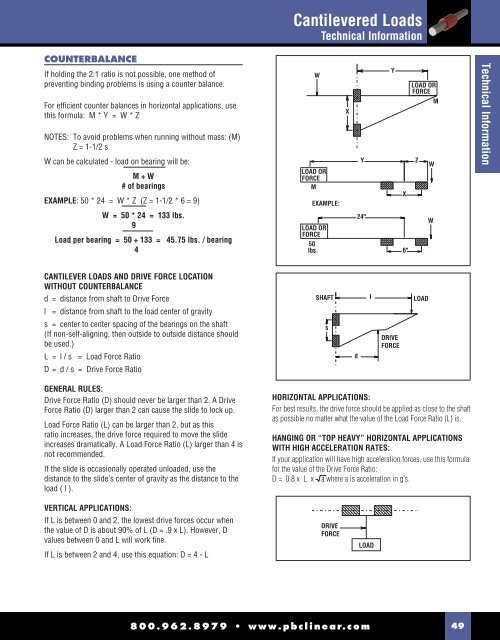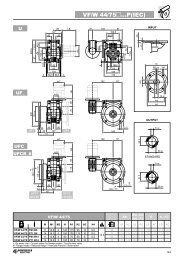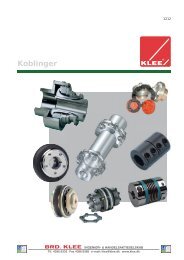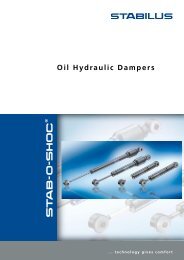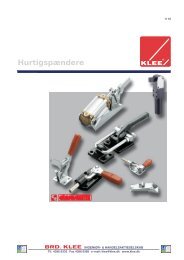LINEAR MOTION SOLUTIONS - Brd. Klee A/S
LINEAR MOTION SOLUTIONS - Brd. Klee A/S
LINEAR MOTION SOLUTIONS - Brd. Klee A/S
Create successful ePaper yourself
Turn your PDF publications into a flip-book with our unique Google optimized e-Paper software.
Cantilevered Loads<br />
Technical Information<br />
COUNTERBALANCE<br />
If holding the 2:1 ratio is not possible, one method of<br />
preventing binding problems is using a counter balance.<br />
For efficient counter balances in horizontal applications, use<br />
this formula: M * Y = W * Z<br />
NOTES: To avoid problems when running without mass: (M)<br />
Z = 1-1/2 s<br />
W can be calculated - load on bearing will be:<br />
M + W<br />
# of bearings<br />
EXAMPLE: 50 * 24 = W * Z (Z = 1-1/2 * 6 = 9)<br />
W = 50 * 24 = 133 lbs.<br />
9<br />
Load per bearing = 50 + 133 = 45.75 lbs. / bearing<br />
4<br />
Technical Information<br />
CANTILEVER LOADS AND DRIVE FORCE LOCATION<br />
WITHOUT COUNTERBALANCE<br />
d = distance from shaft to Drive Force<br />
l = distance from shaft to the load center of gravity<br />
s = center to center spacing of the bearings on the shaft<br />
(If non-self-aligning, then outside to outside distance should<br />
be used.)<br />
L = l / s = Load Force Ratio<br />
D = d / s = Drive Force Ratio<br />
GENERAL RULES:<br />
Drive Force Ratio (D) should never be larger than 2. A Drive<br />
Force Ratio (D) larger than 2 can cause the slide to lock up.<br />
Load Force Ratio (L) can be larger than 2, but as this<br />
ratio increases, the drive force required to move the slide<br />
increases dramatically. A Load Force Ratio (L) larger than 4 is<br />
not recommended.<br />
If the slide is occasionally operated unloaded, use the<br />
distance to the slide’s center of gravity as the distance to the<br />
load ( l ).<br />
HORIZONTAL APPLICATIONS:<br />
For best results, the drive force should be applied as close to the shaft<br />
as possible no matter what the value of the Load Force Ratio (L) is.<br />
HANGING OR “TOP HEAVY” HORIZONTAL APPLICATIONS<br />
WITH HIGH ACCELERATION RATES:<br />
If your application will have high acceleration forces, use this formula<br />
for the value of the Drive Force Ratio:<br />
D = 0.8 x L x a where a is acceleration in g’s.<br />
VERTICAL APPLICATIONS:<br />
If L is between 0 and 2, the lowest drive forces occur when<br />
the value of D is about 90% of L (D = .9 x L). However, D<br />
values between 0 and L will work fine.<br />
If L is between 2 and 4, use this equation: D = 4 - L<br />
800.962.8979 • www.pbclinear.com 49


